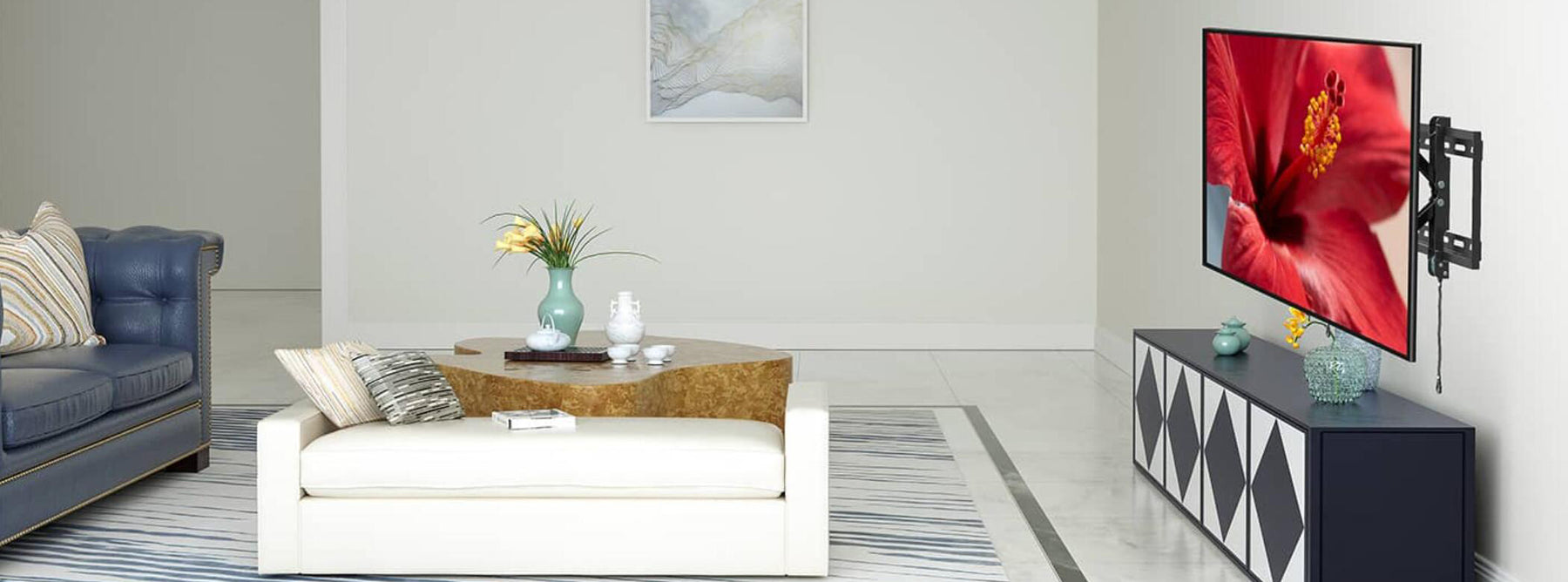
Achieve a modern and sleek look with a low profile TV bracket
1. Understanding Low Profile TV Brackets
A low profile TV bracket, as the name implies, is specifically designed to allow your television to sit close to the wall, creating a sleek and seamless appearance. These brackets are engineered to minimize the gap between the television and the wall, reducing the space required for mounting. Compared to traditional brackets that extend outwards, low profile brackets keep your television display virtually flush with the wall, offering an aesthetically pleasing look with optimal space utilization.
2. Benefits of Low Profile TV Brackets
A. Space-Saving Solution
One of the main advantages of using a low profile TV bracket is the significant space-saving it offers. Traditional brackets often extend several inches away from the wall, which can be cumbersome and obstructive in small spaces. With a low profile bracket, your television will be mounted flat against the wall, freeing up valuable floor space. This is especially important for those living in apartments or smaller homes, where every inch matters.
B. Enhanced Aesthetic Appeal
A low profile TV bracket provides a clean and contemporary look that enhances the aesthetic appeal of any room. By eliminating the unsightly gap between the television and the wall, the bracket creates a floating effect, making your TV appear as if it is a piece of art on display. This sleek and minimalistic aesthetic is becoming increasingly popular among interior designers and homeowners, contributing to the overall modern ambiance of the living space.
C. Improved Viewing Experience
Aside from the visual benefits, low profile TV brackets also enhance the viewing experience by allowing you to position your television at the optimal height. Unlike traditional brackets that are often fixed at a certain angle, low profile brackets provide flexibility in adjusting the height and tilt of the TV. This ensures that the screen is at eye level, reducing neck strain and providing a more comfortable and enjoyable viewing experience.
3. Factors to Consider when Choosing a Low Profile TV Bracket
A. Weight Capacity
Before purchasing a low profile TV bracket, it is crucial to consider the weight of your television. Different brackets have different weight capacities, and choosing one that can support your TV's weight is essential to ensure safety and stability. Manufacturers provide weight limits for their brackets, and it is vital to adhere to these guidelines to avoid any risks of the TV falling or getting damaged.
B. VESA Compatibility
VESA (Video Electronics Standards Association) is a standard that determines the mounting hole pattern on the back of your TV. It is crucial to check the VESA compatibility of both your TV and the low profile bracket to ensure a proper fit. Most brackets accommodate a range of VESA sizes, but it is important to verify the specific measurements, as a mismatch can lead to instability or an improper fit.
C. Cable Management
When choosing a low profile TV bracket, it is worth considering one that offers cable management solutions. Cables and wires can quickly become tangled and messy, detracting from the sleek appearance you are trying to achieve. Opting for a bracket with built-in cable management features, such as cable channels or clips, will help keep the wires organized and hidden, resulting in a neat and clutter-free setup.
4. Installation Tips and Considerations
A. Wall Material
Before installing a low profile TV bracket, it is vital to consider the type of wall you will be mounting it on. Different walls require different mounting techniques, and it is essential to ensure that your wall can support the weight of the TV. For example, if you have drywall, you may need to locate the studs and use appropriate hardware, while brick or concrete walls may require special masonry anchors. It is recommended to consult a professional or follow the manufacturer's instructions to ensure a secure installation.
B. Viewing Angle
When installing a low profile TV bracket, take the time to consider the optimal viewing angle for your space. Think about the seating arrangement in the room where the TV will be mounted and adjust the bracket's positioning accordingly. The goal is to have the television positioned at a comfortable height and angle that allows for optimal viewing without straining the neck or eyes.
C. Professional Installation
While installing a low profile TV bracket can be a DIY project for those with experience and knowledge, it is always advisable to seek professional help if you are unsure. Professional installers have the necessary tools, expertise, and experience to ensure that the bracket is securely mounted, minimizing the risk of accidents or damage. Investing in professional installation can provide peace of mind and ensure that your TV is mounted safely and correctly.
In conclusion, a low profile TV bracket is a perfect solution for achieving a modern and sleek look in your living space. With its space-saving benefits, enhanced aesthetic appeal, and improved viewing experience, it is no wonder that these brackets are increasing in popularity. By considering factors such as weight capacity, VESA compatibility, and cable management, you can select the right low profile TV bracket that perfectly complements your television and space. Whether you choose to install it yourself or hire professionals, a low profile TV bracket will undoubtedly elevate your home entertainment experience while adding a touch of sophistication to your living room.
Popular TV mount collections at USXSTAR:
Explore more TV mounts at USXSTAR:
Full Motion TV Wall Mount 82 Inch
